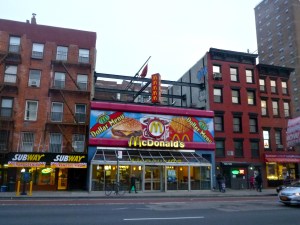Growth of National Chains Slows Significantly in NYC
By Billy Gray December 4, 2013 7:45 am
reprintsFewer national chains opened New York City locations between 2012 and 2013 than in any year since at least 2008 according to a report by the nonprofit research group Center for an Urban Future.
The slight 0.5 percent increase in the number of chain retail locations paled in comparison to the 2.4 percent spike between 2011 and 2012. In fact, there are currently fewer chains in Queens and Manhattan than last year, perhaps giving hope to critics of the city’s supposed transformation into an outdoor mall.

“It really goes in cycles,” said Benjamin Fox, executive vice president of retail leasing at Massey Knakal. “At the moment you’ve got high rents in the competitive streets that a lot of national chains can’t afford combined with a lot of existing chains that have reached their saturation point.”
A total 302 national retailers now have a NYC presence, with 7,226 chain stores across the borough this year compared to 7,190 in 2012. With 515 branches, Dunkin Donuts for the sixth straight year topped CUF’s ranking of the biggest chains in town. The New England-based coffee and munchkin giant became the first nationwide chain with over 500 stores across the five boroughs after opening 39 new locations in the past year, an 8 percent rise. Jonathan Bowles, the executive director of CUF, did not return a request for comment.
Subway was nipping at its heels, closing the year with 467 notoriously pungent sandwich shops. Duane Reade/Walgreens (318 stores), Starbucks (283), MetroPCS (261), McDonalds (240), Baskin Robbins (202), Rite Aid (190), T-Mobile (161) and GNC (138) rounded out the top 10. 7-Eleven didn’t quite crack that threshold, but it posted a big 27 percent increase in locations, from 97 to 124.
But Mr. Fox was wary of the 7-Eleven expansion spree. “They made a huge push 25 years ago, leased a dozen stores and closed them all.”
The retailers with the biggest year-to-year gains were Just Salad (up to 11 locations from 6 in 2012), L’Occitane (14 stores, up from 9)and Trader Joe’s ( 7 locations, up from 5). Meanwhile the biggest losers in terms of store closures were T-Mobile (dropping to 161 from 173 locations), Qdoba, Staples, Sunglass Hut and Tasti D-Lite (all four of them down 7 stores) and Daffy’s, which shuttered all 11 of its city stores.
If the four retailers added to CUF’s ranking are any indication, retailers of vintage duds and spicy food are in for a robust future. The used clothing stores Buffalo Exchange and Second Time Around joined Buffalo Wild Wings and Moe’s Southwestern Grill as this year’s inductees.
The number of chains declined in Manhattan (by 0.7 percent) and Queens (0.4 percent), but rose in the Bronx (by 2.6 percent) and Staten Island (2.7 percent). CUF noted that closures around the South Street Seaport (several on account of Superstorm Sandy) and in the bygone Pier 17 Pavilion accounted for a large share of Manhattan’s overall drop. The report noted that “while the borough had a net loss of 20 chain stores over the past year, the zip code representing the Seaport (10038) registered a decline of 24 stores, by far the biggest drop of any single zip code in New York.”
Given the imminent overhaul of Pier 17 and–on the western edge of lower Manhattan–Brookfield Place, the birthrate of Manhattan chains could surge in the near future. Mr. Fox “disagrees to some extent about a lull, because notwithstanding high rents and lack of availabilities, the city’s filled up with chains.
As for the argument that chain businesses have forced out the city’s mom and pop stores, Mr. Fox said,”That’s all nonsense. It’s been going on since Peter Stuyvesant controlled New York. Good, local retailers stay in business.”
On that note, belying Brooklyn’s status as a capital of everything grass-fed, housemade and hyper-local, Kings County saw the biggest jump in national chain retailers (2.8 percent) of all the boroughs.


